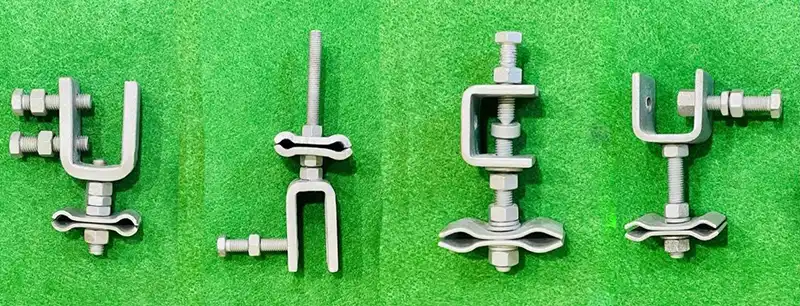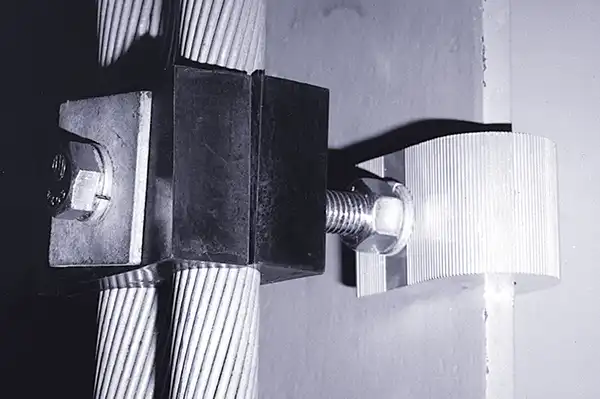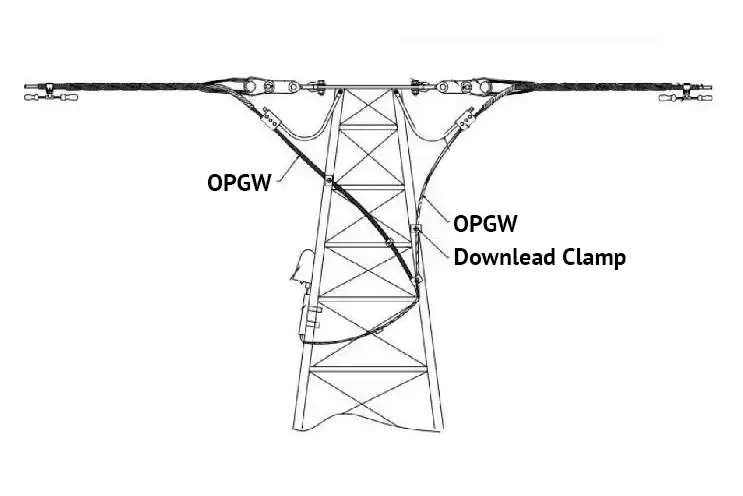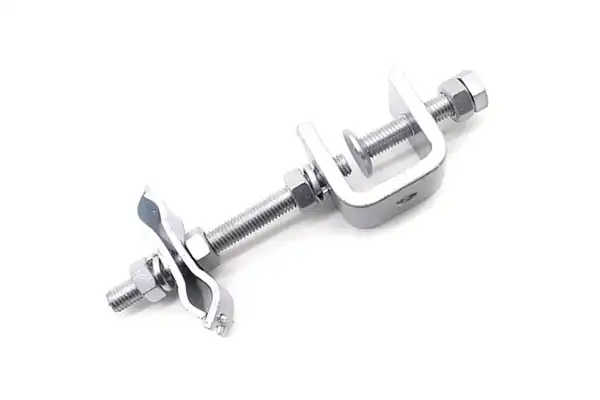TTF is a manufacturer of downlead clamp used on electrical and telecommunication systems. The clamps secure and support cable or conductor hardware that run down a structure, preventing excessive stresses on the cables caused by their own weight or external forces like wind. They reduce the risk of damage or disconnection. It consists of a sturdy metal bracket that mounts to the structure.
Downlead clamps also serve to maintain the desired separation distance between different cables. Some of the clamps have built-in features for grounding or bonding purposes which enhances electrical safety. It also minimizes the risk of electrical surges or static discharge. Downlead clamps play a crucial role in maintaining the integrity and reliability of electrical and telecommunications systems by securing and protecting the downward-running cables.
Common technical specifications
| Structure type | Cable diameter (mm) | Weight (kg) | Application |
|---|---|---|---|
| Hot-dip galvanized | 9.0-11.6 | 0.75 | Tower |
| Hot-dip galvanized | 11.7-14.3 | 0.75 | Tower |
| Hot-dip galvanized | 14.4-17.0 | 0.75 | Tower |
| Hot-dip galvanized | 17.2-19.7 | 0.75 | Tower |
| Steel strip | 9.0-11.6 | 0.55 | Pole |
| Steel strip | 11.7-14.3 | 0.55 | Pole |
| Steel strip | 14.4-17.0 | 0.55 | Pole |
| Steel strip | 17.2-19.7 | 0.55 | Pole |
Reliable downlead clamp matters

In the early 20th century, during the construction of the Empire State Building in New York City, downlead clamps played a crucial role in ensuring the safety and efficiency of the electrical system. The clamps are used to secure electrical cables and prevent them from swinging or coming loose during extreme weather conditions or other stress factors.
The Empire State Building, known for its height and iconic stature, required a robust electrical infrastructure to power its offices, elevators, and lighting systems. The construction team faced the challenge of installing electrical cables that needed to be securely fastened at various points throughout the building’s structure.
To tackle this task, specially designed downlead clamps were employed. These clamps were carefully positioned and attached to the building’s steel framework, providing a reliable and secure anchor point for the electrical cables. They were instrumental in preventing the cables from sagging or becoming damaged due to strong winds or other external forces.
The utilization of these downlead clamps not only ensured the stability and longevity of the electrical system but also contributed to the overall safety of the Empire State Building. Today, the Empire State Building stands as an enduring testament to the innovative engineering techniques and technologies employed during its construction, including the vital role played by downlead clamps.
Components of the downlead clamp
The downlead clamp consist of several components working together to secure and support the cable. These components vary depending on the specific design and application of the clamp. The following are the common part of the downlead clamp:
- Clamp body which holds the cable in place.
- Fasteners such as bolts, nuts and washers to secure the clamp body to the structure.
- U-bolt to hold the cable in place.
- Grounding lug that connects the cable to a ground wire.
- Spacer to maintain a specific distance between the cable and the supporting structure.
- Mounting bracket that allows it to be secure to the supporting structure.
Common types of downlead clamp

The type of downlead clamp depends on the cable type, application requirements and installation environment. The designs are for suiting specific applications and they include:
- Cable clamp
This is the basic type of downlead clamp used for general-purpose cable management. It typically consists of a clamp body with a groove to hold the cable securely in place. - Fiber optic cable clamp
These are designed to secure and protect delicate fiber optic cables. The specific features prevent excessive bending or stress on the fiber optic cable to promote optimal performance. - Combination clamp
Some clamps have a design that accommodates multiple cables of different types. - Messenger clamp
These secure both the messenger wire and the cable simultaneously. The messenger hanger provides additional support and distributes the weight of the cable evenly. - Coaxial cable clamp
Such clamps provide a secure grip and prevent damage to the coaxial cable’s outer insulation. They have a round or oval -shaped channel to accommodate the coaxial cable’s unique structure. - Adjustable clamp
These clamps provide flexibility in terms of cable size and tension. They usually feature adjustable screws or mechanisms that allow for easy customization and fine tuning of the clamp’s grip on the cable. - Ground wire clamp
Ground wire clamps secure and ground the grounding wire. They also have a dedicated lug and terminal for attaching the grounding wire to ensure proper electrical grounding.
Applications of the downlead clamp

Downlead clamps are important in cable management and support which makes them widely used in various industries. These applies in industries where secure and reliable cable connections are required. Below are the various applications of the downlead clamps
- Telecommunications
Downlead clamps secure and support cables like coaxial cables, fiber optic cables and communication wires. They apply in cable TV, broadband internet, telephone network and data centers. - Electrical power distribution
Downlead clamps in electrical power systems secure and support power cable running from overhead power lines to buildings or other structures. They prevent sagging cables and maintain proper tension for a reliable electrical connection. - Transmission lines
The clamps work in high voltage transmission lines to secure and support downleads or jumper cables that connect the transmission lines to distribution or substation equipment. They promote the stability and integrity of the connections. - Antenna installations
The clamps are vital in antenna installations which provides support and strain relief for coaxial cables that connect antennas to communication equipment. They also maintain a proper positioning and alignment of antennas which ensure a optimal transmission and reception. - Outdoor lighting
Downlead clamps are employed to secure the cables that connect lighting fixtures to the power supply. They also help to relief and protect the cables from external forces such as wind and physical impact. - Cable management
Downlead clamps work for general cable management purposes in various settings such as residential, commercial and industrial buildings. They also help to organize and secure cables running along walls, poles or other structures. - Street signage and traffic control
The clamps secure and support cables for street signage, traffic lights and other traffic control systems. This ensures stability and reliability of the electrical connections in outdoor environments.
Installation of the downlead clamps

The installation of these clamps requires careful attention to ensure proper cable support and secure attachment. Some clamps have instructions from the manufacturer that should be considered during installation. It is also advisable to seek assistance from professional electrician or technician. Below is a step-by-step guide to installing the downlead clamps:
- Assess the installation location
Determine the suitable location for installing the clamp. Factors like cable length, proximity and cable path should be considered. - Prepare the mounting surface
Ensure that the surface is clean and free from any contaminations like dirt, rust or paint. - Position the clamp
Place the camp on the mounting surface at the desired location aligning with the groove of the clamp. - Mark the mounting holes
Mark the positions for the mounting holes on the mounting surface. Most of the clamps have multiple holes for flexibility. - Drill the mounting holes
Drill the appropriate bits to create the mounting holes at the marked positions. Ensure that the holes are deep enough to securely anchor the clamp to the mounting surface. - Secure the clamp
Place the clamps over the mounting holes and insert the appropriate screws or bolts though the clamp holes. Add washers and nuts on the other side of the mounting surface. - Tighten the fasteners
Tighten the fasteners to firmly secure the clamp to the mounting surface. This ensure that the clamp is stable and immovable. - Insert and secure the cable
Place the cable into the groove of the clamp and secure it with more fasteners. - Test and adjust
After the cable is secured, check for alignment, tension and stability. Make adjustments to ensure the cable is properly supported and free from excessive stress. - Grounding
Connect the grounding wire to the lug using appropriate connectors if the clamp has a grounding lug.
Choosing the best downlead clamps
When it comes to selecting the best downlead clamp in the market, there are various factors that should be considered. The factors are as follows:
- Environmental conditions which include weather elements like UV radiation, moisture and temperature fluctuations.
- Electrical grounding which ensures that the clamp has a grounding lug or provision for connecting the grounding wire.
- Cost and budget should be considered when balancing it with the required quality and features.
- Cable compatibility which includes the type and size of the cable you need to secure.
- Evaluate the installation method that suits your needs as some might need drilling and mounting.
- Electrical grounding which includes a grounding lug or provision for connecting the grounding wire.
- Check if the downlead clamp complies with the relevant industry standards or regulations.
- Assess the weight and load-bearing requirements of the cable.
- Adjustability and flexibility that allows for tension adjustment and accommodate different cable sizes.
FAQs
A downlead clamp is a device used in electrical and telecommunication systems to secure and support cables or conductors.
Downlead clamps apply in electrical power distribution, telecommunications, antenna installations, cable management, transmission lines and outdoor lighting.
Installation complexity
Corrosion and environmental factors
Interference and crosstalk
Limited adjustability
Cable strain
Cable damage
Cable support and protection
cable organization
strain relief
improved signal quality
enhanced safety
customization and flexibility


